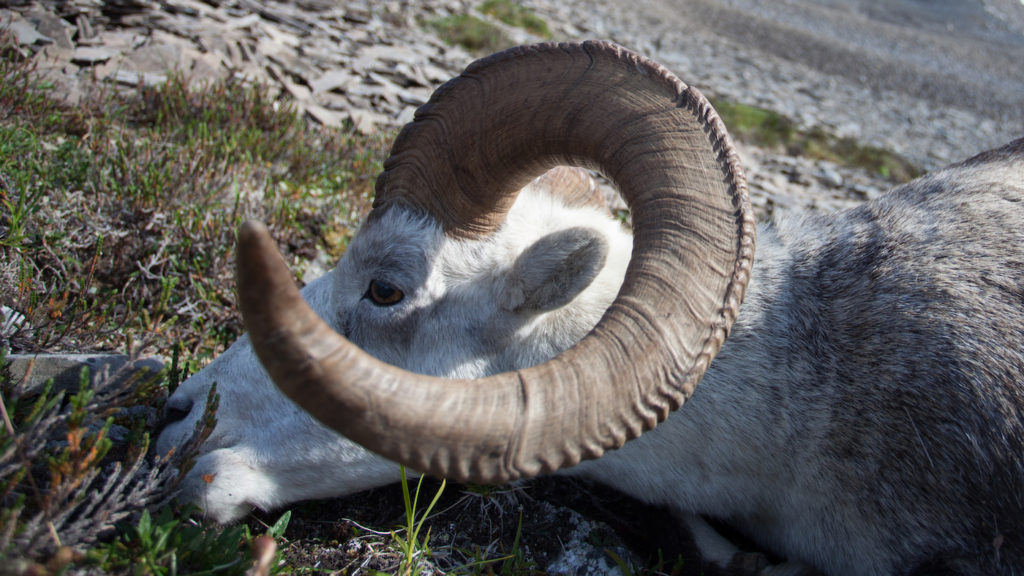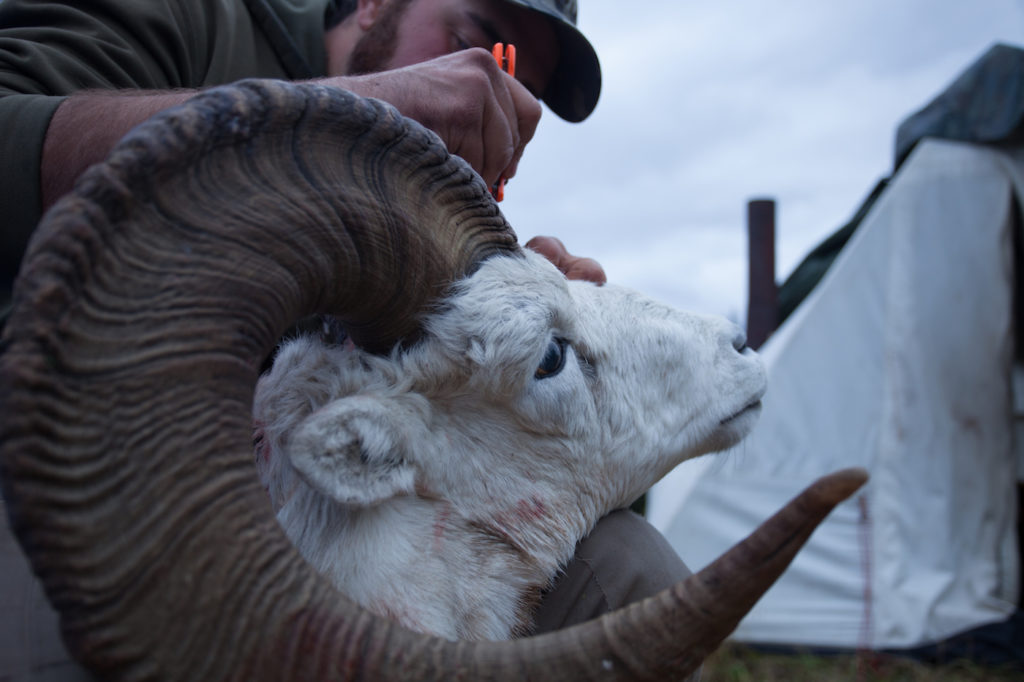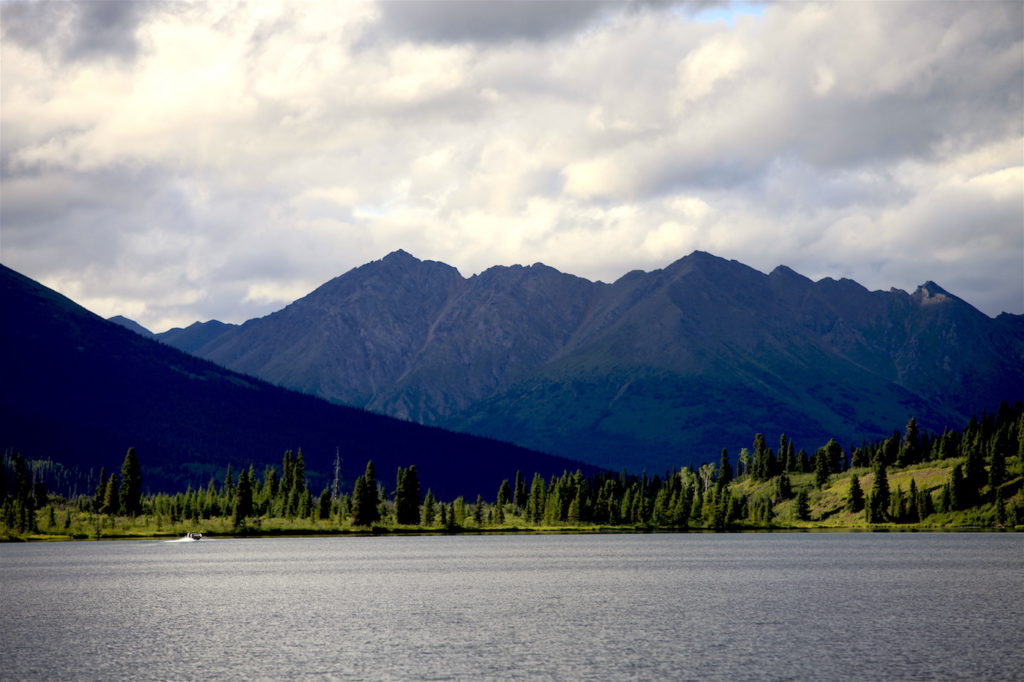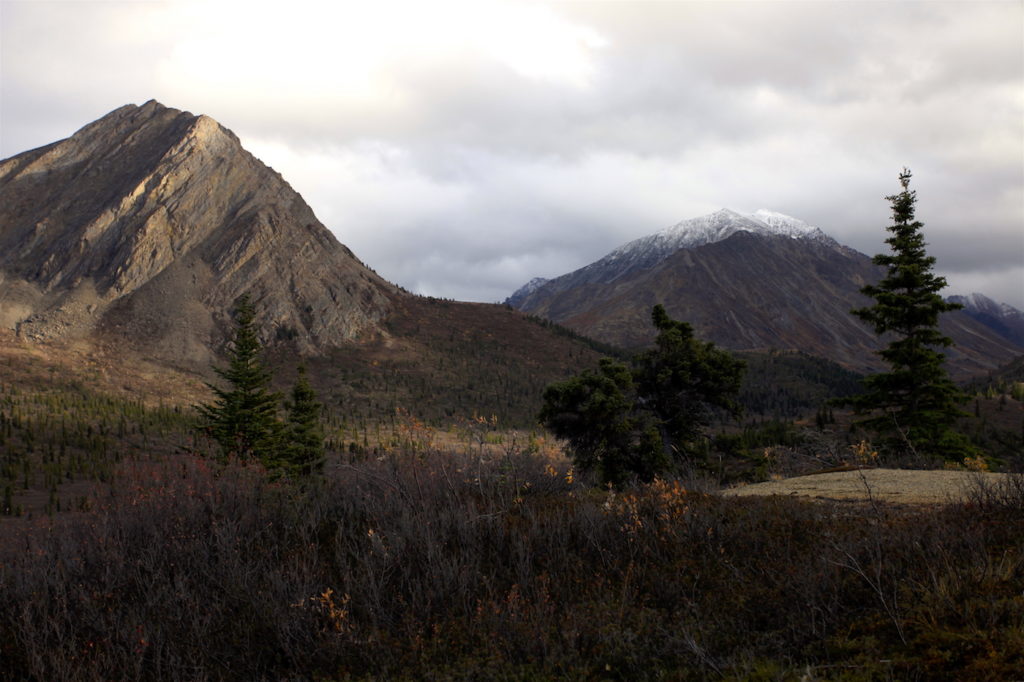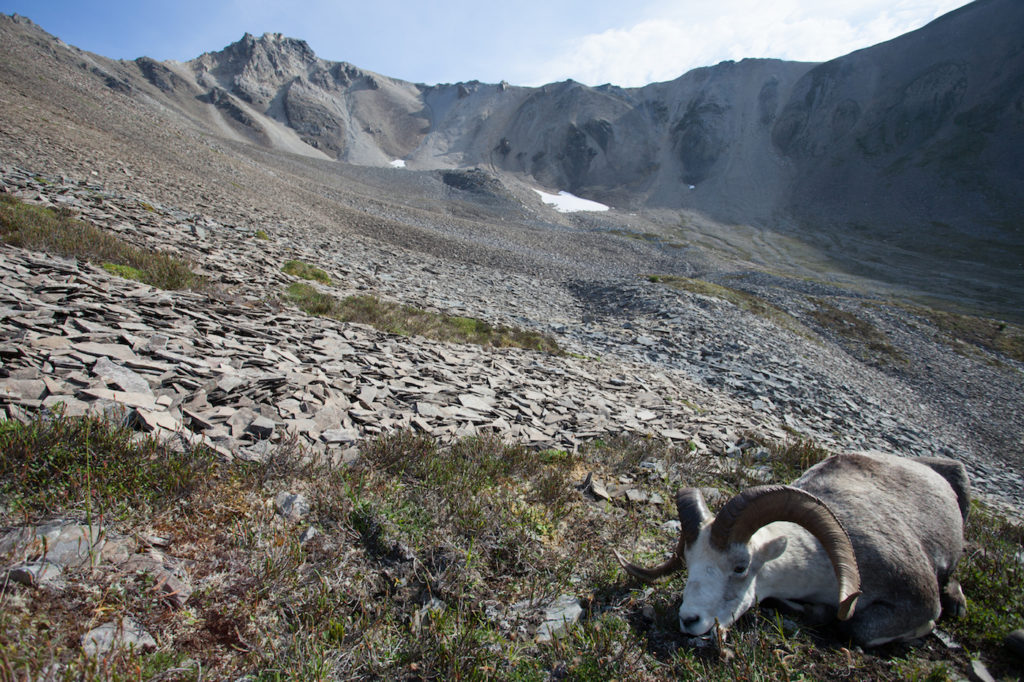There are few destinations still left on this earth that, upon hearing its name, will send any avid mountain hunter into daydreams of wild adventure in untouched country. For most of recorded history The Yukon has held this power. From the days of the Klondike Gold Rush, to the writings of Charles Sheldon and Jack O’Connor, and the modern films of Jim Shockey, the name is synonymous with high adventure.
Nestled in the far northwest corner of Canada, the Yukon Territory covers 482,443 sq km and holds eight of the ten highest mountains in Canada. With a population of 35,874, it goes without saying that many of the Yukon’s game species may live and die without human contact. It boasts vast mountain ranges free of the eyesores of modern society: endless valleys, rivers, and willow flats create ideal habitat for inland grizzly, Alaska-Yukon moose, caribou, and thinhorn sheep. Of the numerous mountain ranges that make up the Territory, the Pelly Mountains of the central Yukon hold rich outfitting and hunting heritage as well as the Yukon’s main population of Stone sheep. The Pelly’s themselves are a subrange of the much larger Yukon Range, yet have three further distinct subranges of their own: the Big Salmon Range, The Glenlyon Range, and the Saint Cyr Range.
“In appearance they are more similar to the Ogilvie ranges than any other mountain group I have seen in the north. But in general they are higher, bolder, more irregular, and rougher; the valleys and canyons are deeper, the crests hold more snow during the summer, the rivers draining them are larger in volume. Timber-line, about 4,500 feet, is higher, and willow and dwarf-birch grow so much more densely on the lower slopes that all the mountains are more difficult to climb than those of the Ogilvies. Nature has carved the Pellys in more rugged outlines than those of the Ogilvies, and has given to them the same rich, contrasting colorations. It has carved even more beautiful basins among them, and filled them with the same kind of exquisite crystal lakes fed by melting snow. The same richly colored flora carpets the slopes.” – Charles Sheldon, The Wilderness of the Upper Yukon
The Stone sheep of the Pelly Mountains dwell in the very northern terminus of their range; with a population of approximately 3,000 sheep spread across 44,014 sq km (a density of roughly one sheep per 14 sq km), it’s no surprise that resident hunting pressure is virtually non-existent. While the rams that do dwell there are few and far between, the superb genetics and lack of hunting pressure have resulted in a plethora of forty-inch-plus rams taken over the years. I personally believe that this area consistently boasts some of the most beautifully-caped Stones, with snow-white face and rump patches, as well as dark blue or black through salt-and-pepper saddles being common. Perhaps that is just my own bias, as the first Stone rams I laid eyes on called these mountains home, but I do find that a well-defined separation in a ram’s coloring lends itself to a more regal look.
As is common with most game in this region, the Stones will be found in pocketed locations, with many miles between bands of rams. Not every mountain appears to hold rams, and unlike the majority of northern British Columbia, you likely will not have your pick of the litter when it comes to shooting one. The rams here are not the open-alpine wanderers of their northern thinhorn kin and tend to spend copious amounts of time below timberline, further increasing the difficulty of finding mature specimens. That said, I do believe that a sheep hunt should never be a guarantee, and if one is inclined to work harder, hike further, and glass patiently for his quarry, the results can certainly pay off. The key to booking a hunt here is searching for the outfitters that hunt Stones selectively and conservatively. Much of the area is on more of a suggested quota than an affixed one, and I’m of the belief that less is more when it comes to ram harvests in these low-density areas.
Like many hunters, I covet the high-mountain species of sheep and goat, but when the mercury drops and the mountaintops are frosted over with snow, my thoughts turn to the largest subspecies of moose—the Alaska-Yukon. While bulls over 70 inches are a possibility, a greater number of high-fifties to mid-sixties bulls are more normal. Perhaps naive, but growing up in eastern Canada I was of the belief that moose were lowland-dwelling swamp creatures. Low-lying rivers, bogs, and densely-timbered coniferous forests were the home of the eastern moose.
It was to my great astonishment the first time I laid eyes on two cows sauntering over the barren ridge of a mountain. While I feel they are often overlooked by the serious mountain hunter, I have gained much admiration and respect for these giant ungulates. Their ability to move, seemingly effortlessly, across great, tangled willow flats, through bog and mud that will sink the surest-footed of horses, and over the crumbling rock and shale of the mountains, is nothing short of amazing to witness. The Pelly Mountains truly are a moose hunter’s heaven. It is hard to find a valley bottom or willow bench that isn’t littered with moose sign, and there have been more than a few occasions where I’ve lost count of the number of sheds passed while trailing horses.
Due to the logistics of transporting camp, head, hide, and meat, it’s safe to say that many valleys are seldom-hunted, and great bulls succumb to old age in this country. Though I believe the opposite to be true of hunting sheep, moose beg to be hunted from the saddle of a good mountain horse. The headache that horses often bring is well worth the reward while chasing these long-legged beasts. Aiding not only in the transportation of downed moose, a decent horse will outpace the best of us two-legged folk when it comes to crossing the many rivers, bogs, and willow tangles that moose frequent.
Boat hunts can be another popular option, and if the timing is right, an incredibly successful and exciting one. There is a small window before the cows hit the high country, when bulls are low and responsive to calls, often creating multiple opportunities over the course of a hunt. Also, if you are an archery hunter, Alaska-Yukon moose should certainly be on your list, as the possibility of calling them to bow range is fantastic. If a mature bull standing within arrow range and looking for a fight doesn’t increase your heart rate, you should likely see a physician.
Another great—and often overlooked—ungulate of the Pelly’s is the mountain caribou. I consider them often-overlooked, as they are rarely the target species of a hunt and tend to be an add-on if encountered. Arguably as pocketed in their densities as the Stone sheep, the Pelly Mountains do hold some exceptional genetics (there’s a common thread here…) when it comes to caribou. The current B&C world record mountain caribou was taken in the Pelly’s in 1988, with a score of 459 ⅜”. While it may be unrealistic to expect to find such an astounding specimen these days, Caribou in the high-300’s and low-400’s still roam these hills. Caribou in the Pelly’s can be found wherever they damn well please, as these animals tend to roam without any apparent cause. I have witnessed bulls come within 100 yards of a dozen horses feeding with bells on in July, cows wandering the saddles and ridges of the highest peaks, lone bulls bedding in the timbered bluffs above the snowline in October, and whole herds running until they disappeared in the distance of the valley for what seemed like no reason at all.
Finally, we come to the great bears that call the Pelly’s home: the inland grizzly. Few animals command the same awe and respect as grizz, while at once defining the term “wilderness.” The mountain grizzlies of the Yukon thrive only in vast, undisturbed spaces, and unlike their coastal brethren, mature bears tend to have massive territories in which they roam. The Pelly Mountains do hold some of the highest densities of grizzlies in the Yukon, yet because of their nomadic nature, it is rare to see multiple bears in the same general area. Much like caribou, they are very much an object of opportunity in the Yukon. That isn’t to say they cannot be targeted as the main species of a hunt, just that their numbers are not so vast, and their behavior so nomadic that finding a good one can be a great game of patience.
While the river beds are nearly always pounded with grizzly sign of all sizes, it is much more common to catch them feeding across old avalanche slides and high-mountain berry patches. One observation I have made is that nearly every hitching rail, saddle rack, or de-limbed tree used for tying horses have remnants of the previous spring’s rubbing on them. Long, golden-brown hairs snagged under the head of an old nail, between the layers of bark on a cedar, or on the pitch of a fresh saddle rack stand as a reminder that you are in their home, not the other way around.
Boars of these mountains tend to be much darker in color than sows, with big ones going seven-and-a-half-feet or more, and the occasional outstanding bear taping out over 8 feet. An added benefit of hunting bears in the Yukon is that you can hunt them over carcasses, greatly increasing the odds of finding one of these reclusive mountain beasts. Combined with a late-season moose or caribou hunt, the grizzly is a great additional species to chase. After tagging out on moose in a late-September camp this past fall, the clients, myself, and another guide went riding for the day to check carcasses for bear activity. Upon finding a boar snoozing soundly, we were astonished at how much effort it had dedicated to digging earth to bury the deboned bull moose carcass in a mound. In an area you would swear had no more dirt than would fill a wheelbarrow, the boar had managed to completely hide the moose. Were it not for the freshly-clawed earth and odd bit of bone or hooves poking out, you would never know an entire moose skeleton and gut pile had been there.
In this day and age, with a global community and endless amounts of data at our fingertips, it can be hard to narrow down where one may want to spend the time and finances on a dream hunt. For some it is simply that: a once-in-a-lifetime opportunity in the purest sense. With hunt prices climbing well into the tens of thousands, and every outfitter boasting of great success and trophy class, how can you be sure? Perhaps you have a tight budget, or no interest in hunting from horses. Perhaps you have limited time off, and cannot invest 10 to fourteen days or more—not including travel time—on an epic hunt. Your reasons and choices of where you hunt are personal and variable.
But of the Yukon’s mighty Pelly Mountains I can tell you this: If one is so inclined to soak in the beauty of these rugged mountains while searching for game, they can be one of the most visually-pleasing places to hunt in the world. Few and far between are the places left in North America where you can stand on a mountain summit and see no sign of humankind in any direction. While glassing for rams in this country, I’ve had the pleasure of watching lambs and ewes feed in and out of the willows lackadaisically, while a lone caribou bull wandered the barren ridge of a plateau several miles off. Many a frosty morning I have witnessed the Northern Lights dancing in the sky like iridescent candles, while I pushed horses back up the valley towards camp. I’ve observed Arctic Grayling flickering in and out of the riffles of tiny mountain streams on long trail days with the horses, and occasionally roasting one, whole, over the coals of a streamside fire for dinner.
If you seek incredible densities of game, short hunts, and punching a tag in the first couple days, perhaps the Pelly’s are not suited to you. For those willing to push harder, putting in long days on foot and horseback, who seek some of the greatest wilderness Canada has to offer and the lure of an exceptional class of trophy and experience, you may find the song of the Yukon’s Pelly Mountains particularly soothing to your ear.
There is only one way to find out.




